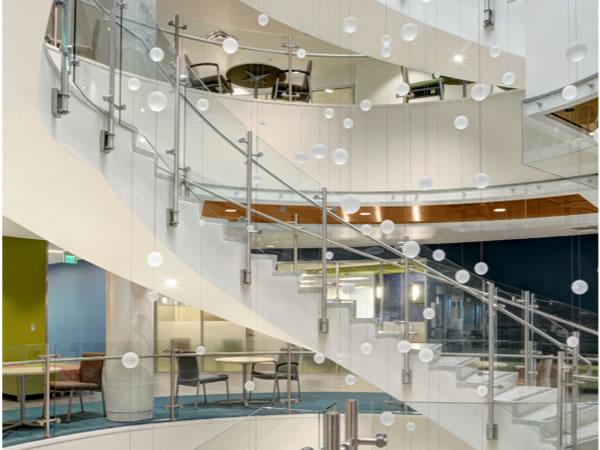
Date: 7 March 2019
From preconstruction through final inspection, 3-D scanning and measurement is an integral element of architecture, engineering and construction. It’s an innovative solution that continues to gain momentum on job sites for its ability to collect highly accurate information in a very short period of time.
While the technology behind 3-D laser scanning has been around for years, the building and architectural metal industries are just beginning to tap into its potential, particularly for stadium and athletic facility construction. According to KPMG’s Global Construction Survey from 2016, the industry is starting to embrace this technology, and just over 20 percent of respondents said they’re changing their business models to accommodate its rapid growth.
As a leading national provider of architectural railings, Trex Commercial Products has nearly three decades of experience manufacturing ornamental railing systems and working with architects, general contractors and glaziers. During this time, we’ve seen several rising challenges within the metal architecture industry – including shorter building cycles, shrinking budgets and the need to produce accurate data at a moment’s notice.
3-D scanning technology offers tremendous benefits for both the client and the surveyor. In the short-term, it provides accurate measurements for design and construction, while in the long-term, it provides clients with valuable survey information that can aid in planning future maintenance or reconfiguration of the space.
What is 3-D Laser Scanning?
Laser scanning, also called high definition surveying (HDS), is a method of high-accuracy mapping or reality capture that uses lasers to quickly capture complete field detail of an entire building construction project. These lasers scan or sweep across objects, measuring millions of points with XYZ values. The result is an accurate 3-D depiction of the scanned building site called a point cloud that can be converted to AutoCAD, MicroStation and several other design formats.
Key Advantages
High definition surveying offers a wide array of benefits, including decreased project costs, faster turnaround, improved safety, reduced rework and higher quality data capture.
- Speed, Accuracy & Consistency – 3-D laser scanning enables a faster project turnaround and accurate means of collecting millions of measurable data points in seconds. In addition, measurement scanning can be completed without significant interruption of surrounding activities – a major benefit when working on compressed deadlines.
- Valuable Data for Design – The richness of the data from 3-D scanning gives clients peace of mind that measurements are accurate and thorough. Even after project completion, building management can have access to virtually every detail of the building’s design, all of which can be valuable for future purposes.
- Improved Safety – Laser scanning is hands off, making it unobtrusive and safer. Also, the technology enables project managers to obtain measurements for difficult, hard-to-reach and sometimes dangerous areas of a building site – a process that could potentially take days, and bring other on-site work to a halt.
- Cost Advantages – Imagine the time and money savings on a project that requires zero remakes. By exposing any inaccuracies early in the process, 3-D scanning allows you to quickly resolve them before they became larger issues during construction and installation.

Primary Uses
From healthcare settings to educational facilities and major athletic arenas, this emerging technology is scalable and can be used for smaller venues as well as large-scale projects.
For large professional sports complexes, 3-D scanning allows Trex Commercial Products to create ornamental railings that enhance accessibility and safety, contributing to the overall fan experience, while also complementing each facility’s unique design and architecture.

Using the point cloud data captured on-site, Trex Commercial Products created a 3-D model of U.S. Bank Stadium.
In addition, 3-D laser scanning services can help identify the exact locations and dimensions of structural elements like columns, seating, stairs and risers – valuable information for stadium modifications, including extending railing barriers for fan protection or upgrades to VIP suite sections.
HDS can also prove beneficial for universities and hospitals to museums and hotels. For instance, Trex Commercial Products utilized a 3-D laser scanning system to create railing for a spiral staircase at Colorado State University Health and Medical Center. Given the tight deadline and complexity of the work, the technology allowed us to accurately – and quickly – model the unique shape and contours of the staircase.

3-D laser scanning provided Trex Commercial Products with accurate dimensions that lead to swifter and easier installation.
Embracing the potential of new technology like high-definition surveying provides a tremendous competitive advantage. While only a small percentage of companies in the industry are implementing this advanced tool, it allows us to participate in some of the largest commercial railing projects in the country. By utilizing 3-D modeling, we’re able to provide a compliant product, in a cost-effective manner that accommodates any project’s requirements.
 600450
600450
















Add new comment